
A flock of geese flying in a “V” formation, a herd of bison thundering across the plains, and a school of sardines swimming in unison are all examples of animals moving together in groups.
While ecologists and animal behavior specialists have studied these group behaviors for years, scientists at the University of California San Diego are now exploring how these behaviors originate in the brain.
Published in the journal Current Biology, Postdoctoral Scholars David Zada and Lisanne Schulze in Assistant Professor Matthew Lovett-Barron’s laboratory have been studying tiny transparent glassfish (Danionella cerebrum) to uncover how groups of animals coordinate their movements.
“Collective social behaviors, such as fish schooling and bird flocking, are remarkable displays of behavioral complexity in the natural world, but little is known about how these behaviors emerge from the interacting brains of many individuals,” said Lovett-Barron, an assistant professor in the Department of Neurobiology.
“We don’t know very much at all about how neural processes in individual animals produce cooperative behaviors.”
The researchers found that glassfish rely on their vision to swim in groups. While some fish species use their sense of water flow to swim together, glassfish use sight alone, as revealed through a series of experiments.
Using machine learning tools to track the movements of fish across different ages, they discovered that the ability to follow coordinated group movements develops as the fish mature.
Much like how newborn humans develop social skills as they grow, glassfish refine their ability to swim in coordinated groups over time.
Fish raised in normal social environments avoided other fish at two weeks old, started to gather with others at four weeks, and achieved full social alignment in schools by six weeks.
Because glassfish are highly transparent, the researchers could capture images of their brain activity using optical microscopes. They recorded thousands of neurons across the brains of glassfish immersed in a virtual reality environment where the fish viewed moving fish-like shapes that mimic schooling.
The researchers identified active circuits by recording images of GCaMP, a fluorescent protein in neurons. GCaMP glows brighter in the presence of calcium, which enters cells when neurons are active.
These recordings showed that glassfish brains respond to the sight of their social partners and that maturity is crucial for social vision.
While glassfish of all ages could perceive the motion of virtual social partners, only older fish could distinguish between fish-like shapes and non-fish-like shapes.
The researchers believe this visual ability allows glassfish to align their bodies with their social partners to swim in schools. Fish raised in isolation showed impaired schooling behavior and immature visual processing compared to those raised in groups.
“In nature, we see that large animal groups can move as a cohesive unit, and our laboratory is working to understand how the brains of individuals are able to pay attention to the actions of their social partners to produce this group-level behavior,” said Lovett-Barron. “In this study, we found that these social abilities emerge progressively over the course of development as the nervous system matures.”
Glassfish, only 10–12 millimeters long as adults (about the width of a pencil), have recently become a model system for biological studies.
Unlike the widely studied zebrafish, which loses its small size and transparency as it ages, glassfish remain small and nearly transparent throughout their lives, providing new opportunities for biologists to observe the brain in action.



